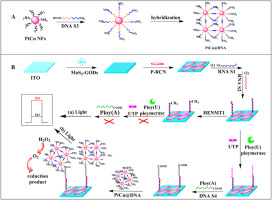Biosensors and Bioelectronics ( IF 12.6 ) Pub Date : 2017-12-21 , DOI: 10.1016/j.bios.2017.12.035 Haiyan Wang , Libang Zhu , Junling Duan , Minghui Wang , Huanshun Yin , Po Wang , Shiyun Ai

|
2′-O-methyl group on the 3′ terminal nucleotide in plant microRNAs, as one kind of RNA methylations, is caused by HEN1 RNA methyltransferase (HENMT1), which is thought to be crucial for ribosome biogenesis and function. Herein, a simple and label-free PEC biosensing method was proposed for assay of HENMT1 activity and inhibitor screening based on peroxidase mimic PtCu nanoframes (PtCu NFs) catalytic signal amplification. In this work, MoS2@Graphene quantum dots/Phosphorus-doped rodlike carbon nitride (MoS2@GQDs/P-RCN) heterojunction was used as photoactive materials. With the doping of GQDs and the formation of heterojunction, the photoactivity of MoS2 is greatly improved. After the double-stranded RNA (dsRNA) with 2 nt 3′ overhangs was treated with HENMT1 in the presence of S-adenosyl-L-methionine, the 3′ terminal nucleotide of the unmethylated dsRNA could be extended under the catalysis of the poly(U) polymerase in the existence of UTP. Poly(A) nucleotide chain modified with carboxyl group was captured on the electrode surface through hybridization reaction and acted as a bridge for the immobilization of reticular DNA-functionalized PtCu NFs ([email protected]). Under the catalysis effect of peroxidase mimics [email protected] towards hydrogen peroxide, O2- was in situ generated as electron donor and a strong photocurrent was obtained. The proposed PEC bioassay exhibited high selectivity and low detection limit of 3.36 ng/mL for HENMT1 activity assay. Furthermore, the inhibition research indicated that chlorpyrifos could inhibit the HENMT1 activity with the IC50 value of 48.32 nM.
中文翻译:

用于使用过氧化物酶检测HEN1 RNA甲基转移酶的光电化学生物传感器,模拟PtCu NFs和poly(U)聚合酶介导的RNA延伸
植物微RNA中3'末端核苷酸上的2'-O-甲基是一种RNA甲基化,是由HEN1 RNA甲基转移酶(HENMT1)引起的,该酶对于核糖体的生物发生和功能至关重要。本文中,基于过氧化物酶模拟PtCu纳米框架(PtCu NFs)催化信号放大,提出了一种简单且无标记的PEC生物传感方法,用于HENMT1活性测定和抑制剂筛选。在这项工作中,MoS 2 @石墨烯量子点/磷掺杂的棒状氮化碳(MoS 2 @ GQDs / P-RCN)异质结被用作光敏材料。随着GQDs的掺杂和异质结的形成,MoS 2的光活性大大改善了。在S-腺苷-L-甲硫氨酸存在下,用HENMT1处理具有2 nt 3'突出端的双链RNA(dsRNA),未甲基化dsRNA的3'末端核苷酸可以在多聚催化下延伸。 U)聚合酶在UTP的存在下。通过羧基修饰的羧基修饰的聚(A)核苷酸链通过杂交反应被捕获在电极表面,并充当固定网状DNA功能化PtCu NFs的桥梁([受电子邮件保护])。在过氧化物酶模拟物的催化作用下(电子邮件保护)对过氧化氢O 2-原位产生电子作为电子供体,并获得强光电流。拟议的PEC生物测定法对HENMT1活性测定法显示出高选择性和3.36 ng / mL的低检测限。此外,抑制研究表明毒死rif可以抑制HENMT1活性,IC 50值为48.32 nM。


























 京公网安备 11010802027423号
京公网安备 11010802027423号